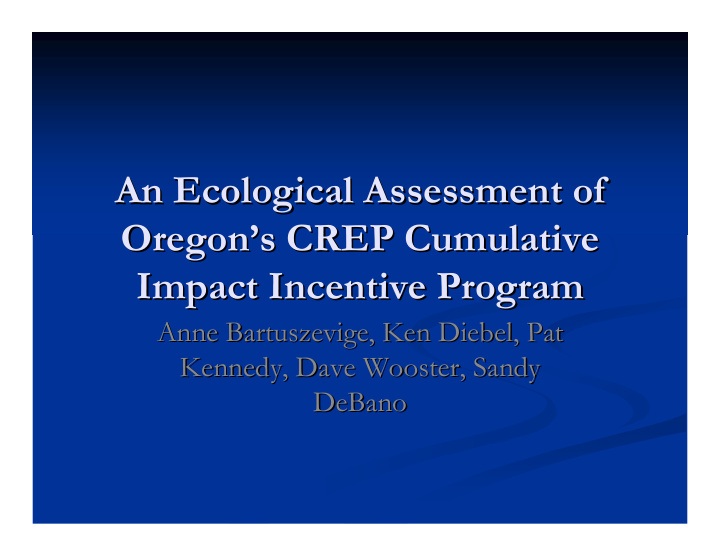



An Ecological Assessment of An Ecological Assessment of Oregon’ ’s CREP Cumulative s CREP Cumulative Oregon Impact Incentive Program Impact Incentive Program Anne Bartuszevige, Ken Diebel Diebel, Pat , Pat Anne Bartuszevige, Ken Kennedy, Dave Wooster, Sandy Kennedy, Dave Wooster, Sandy DeBano DeBano
Riparian Buffers Riparian Buffers � Absorb floodwaters Absorb floodwaters � � Filter sediment and nutrient runoff Filter sediment and nutrient runoff � � Regulate water temperature Regulate water temperature � � Provide woody Provide woody debris debris inputs to rivers inputs to rivers �
Oregon CREP Oregon CREP � Focus on streams with T&E salmon species Focus on streams with T&E salmon species � � Pay competitive rental rates to producers Pay competitive rental rates to producers � � Cumulative impact program Cumulative impact program � � >50% of a 5 mile stretch of stream enrolled into >50% of a 5 mile stretch of stream enrolled into � program program � One One- -time payment of 4 times the annual rental rate time payment of 4 times the annual rental rate �
Methods Methods � Select buffered and Select buffered and unbuffered unbuffered areas along areas along � streams with similar geography and upland land streams with similar geography and upland land use. use. � Selected 9 buffered and 3 Selected 9 buffered and 3 unbuffered unbuffered sites along sites along � 3 streams in Wasco County, OR 3 streams in Wasco County, OR � Fivemile Fivemile Creek Creek � � Eightmile Eightmile Creek Creek � � Fifteenmile Fifteenmile Creek Creek �
Methods - - Macroinvertebrates Macroinvertebrates Methods � Methods similar to OR DEQ Methods similar to OR DEQ � � Sample in riffle/fast water habitat Sample in riffle/fast water habitat � � D D- -frame kick frame kick- -net net � � Samples sorted in lab, Identified to lowest Samples sorted in lab, Identified to lowest � taxonomic order (usually Genus) taxonomic order (usually Genus)
Environmental Variables Environmental Variables � Wetted width Wetted width � � Substrate composition ( Substrate composition (Wohlman Wohlman pebble count) pebble count) � � Water depth and velocity Water depth and velocity � � Solar exposure (Solar Solar exposure (Solar pathfinder pathfinder TM TM ) ) � � Specific conductance Specific conductance � � pH pH � � Turbidity Turbidity � � Temperature Temperature �
Vegetation Sampling Vegetation Sampling � 15 m transects extending perpendicular from 15 m transects extending perpendicular from � stream flow to upland stream flow to upland � Estimate percent in 1 m2 frames at 6 distances Estimate percent in 1 m2 frames at 6 distances � along transect (0, 1, 2, 4, 8, 14 m) along transect (0, 1, 2, 4, 8, 14 m) � Count number of woody stems in 4 X 15 m belt Count number of woody stems in 4 X 15 m belt � transect transect � Collected soil sample Collected soil sample � � Placed seed trap in stream Placed seed trap in stream �
28.7% of individuals identified were mayflies, stoneflies, and caddisflies. Buffered areas had significantly higher percentages of these taxa than unbuffered areas
No significant effect of buffer length on EPT taxa richness, Percent EPT taxa, and Index of Biotic Integrity
Plant Sampling Results Plant Sampling Results � 222 herbaceous plant species identified 222 herbaceous plant species identified � � 95 herbaceous species were exotic 95 herbaceous species were exotic � � 11 are classified as noxious weeds in OR 11 are classified as noxious weeds in OR � � 38 species of woody vegetation 38 species of woody vegetation �
No difference in plant community composition between buffered and unbuffered sites
Conclusion Conclusion � Buffered sites have higher stream quality than Buffered sites have higher stream quality than � unbuffered sites. sites. unbuffered � Only for one index. Only for one index. � � Longer buffers did not have higher stream Longer buffers did not have higher stream � quality quality � Unlike other studies who have shown a relationship Unlike other studies who have shown a relationship � between stream quality and buffer length between stream quality and buffer length
Conclusion Conclusion � No differences in vegetation. Riparian areas are highly No differences in vegetation. Riparian areas are highly � disturbed and ruderal ruderal species are adapted to these areas. species are adapted to these areas. disturbed and � Visual differences between buffered and Visual differences between buffered and unbuffered unbuffered � sites were small. sites were small. � Chose Wasco County because of the large area in Chose Wasco County because of the large area in � buffers. buffers. � Larger differences may be found if more obvious Larger differences may be found if more obvious � differences were present between buffered and differences were present between buffered and unbuffered areas. areas. unbuffered
� Thanks to OWEB for funding this project. Thanks to OWEB for funding this project. � � Thanks to field assistants who helped with the Thanks to field assistants who helped with the � vegetation and macroinvertebrate macroinvertebrate sampling. sampling. vegetation and � Thanks to OSU EOARC and Hermiston Thanks to OSU EOARC and Hermiston � station. station.
Recommend
More recommend